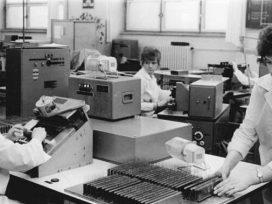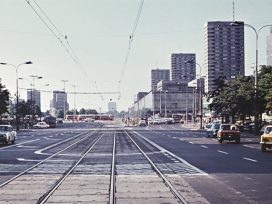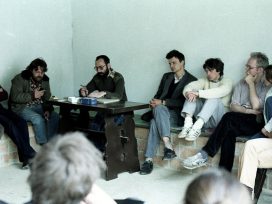Looking back on the past fifteen years, one sees in Europe a turbulence in the politics of memory: every day, a new exhibition is opened, a national commemoration day celebrated, a memorial unveiled, a new lesson of history taught – as if we were living in the “age of memory”, as many historians and philosophers say. Comparing the eastern and western parts of Europe, however, one witnesses as much similarity in the fore of the politics of history as difference in its background, namely, in social memory. Will there be a common European memory acceptable to a majority of citizens, no matter what part of Europe they come from, any time soon? Why are the deeper levels of social memory still felt to be essentially different from the visible commonalities? Finally, as regards social memory itself, is there a system-specific difference between Eastern and Western types of social memory, and if so, when did it emerge?
In order to answer these questions, I would like to take advantage of the fact that I happen to commute between Austria and Hungary. The former will represent a Western democratic society and the latter an ex-communist one. I will use an emblematic component of social memory in these countries, the memory of the Shoah, to highlight two phenomena:
1. The conflict between the scattered and fragmented perspective of the victims and the wider general politics of memory.
2. The discrepancy between the histories of Western democratic and Eastern ex-communist social memory, with references to the Austrian and Hungarian cases.
In order to understand the ambiguities of the European “age of memory”, I will begin with a short definition of three key categories: the politics of history, personal memory, and social memory. The politics of history is first of all a source of political legitimacy. It justifies, with moral arguments, political goals by means of historical narratives. These narratives identify the roles and tasks of those persons and social groups that take part in politics. Personal memory works inversely: it is the engine of self-representation, or personal identity. It stabilizes the self and harmonizes it with social identities. Finally, social memory tries to bridge the inherent gap between the politics of history and personal memories. I will concentrate on attempts at reconciling the politics of history with personal memory in Austria and Hungary. In order to examine these attempts in the two countries at the same time, I will borrow the method of histoire croisée invented by social history writing. Instead of making a detailed comparison, this method focuses on the crossovers of different cultures, social groups, and historical events. Similarly, mémoire croisée would mean the real meetings/crossovers between the politics of history, and personal and social memories in different political systems.
Mémoire croisée I. The perspective of the victims
In 2004-2005, I worked together with Austrian colleagueson a project that mapped the individual experiences and memories of Austrian and Hungarian women who were survivors of the Shoah. The survivors had undergone the same experience: they were deported as Jews to Ravensbrück and Auschwitz-Birkenau where they were subjected to forced sterilization. According to our working hypothesis, despite their having had the same experiences at the time, because of the different political systems of the two countries in which they live and the different social realities of their after-war lives, today they must construct different perspectives of memory. In other words, we used a Western commonplace, according to which a democratic society, by definition, provides more opportunity for the wounds of the Shoah to heal than a totalitarian one. After analyzing the interviews, we had to face the fact that the narratives showed no differences in this respect. I will return to this perspective – or rather “lack of perspective” – at the end.
Mémoire croisée II. The memory of National Socialism and Communism
We formulated our hypothesis of the healing effect of democracy on the basis of standard historical observations of national and trans-national memory. Unfortunately, the majority of these observations focus on Western ways of remembering, that is, on Western cultures of memory and politics of history; the authors develop general models and theories from this perspective.For example, Charles S. Maier used a metaphor from nuclear physics to highlight the differences between the memory of National Socialism and Communism. A “hot memory”, like plutonium, has a long half-life in history, while a “cold memory”, like tritium, has a short one, Maier argued, concluding that the memory of Nazism is hot, whereas the memory of Communism is cold. As far as I can see, memory in eastern Europe works the other way round: remembering Communism has become a very hot issue that mobilizes great numbers while the memory of Nazism remains cold. However, there are only a few comparative studies on the social memory of totalitarian regimes in the region. Until now, the memory of Communism and Nazism was researched in an “either-or” mode in eastern Europe: historians became specialists of either the Shoah or the GULag.
Mémoire croisée III. Global, European and local memories
The first cultural exchange of social memories between eastern and western Europe took place under the aegis of the globalization of memory of the Shoah. Paradoxically, this process of exchange was initiated outside Europe – namely in the United States. It went hand in hand with the anthropologization of victimhood. In the framework of globalization, a visual as well as an oral master-narrative remembering the Shoah were exported to Europe, while anthropologization led to the mushrooming of institutes of genocide research all over the world.
The Shoah became a yardstick of suffering in the global age. Hence, the memory of the Shoah became a universal container for different groups of victims. Discussing the Yugoslav war during the 1990s, many accepted the slogan “Never again Auschwitz”. Stalinism was labelled a “Red Holocaust”. A major initiative in the politics of history in the US resulted in a global institutional network with the imperative “Never again”. These frameworks were fully internalized by Europe in the course of the past decade.
Despite the sometimes problematic manner of European reception, globalization and anthropologization helped eastern European societies adopt ready-made frameworks, rituals and narratives commemorating the Shoah after forty years of silence. The accumulated knowledge of the West made the production of a new culture of memory easier in the everyday life of ex-communist societies.
The success of globalization originates in the lack of local memories. The Shoah destroyed the substance of European Jewishness, which depended on flourishing communities. The Jewish people and their communities disappeared from their physical and symbolic places. The survivors left their former homes because they didn’t want to be confronted with the crying emptiness of these places and the lack of solidarity of the neighbours. The forced migration of the survivors and the indignation of society at remembering resulted in the dislocation of the Shoah itself. In sum, it is no wonder that the memory of the Shoah became centralized and dislocated in Europe as a whole.
Mémoire croisée IV. The memory of the Shoah and of the expulsion of ethnic Germans
Interestingly, the subsequent crossing between East and West was initiated by another group of victims. At the turn of the millennium, an embarrassing debate broke out in Germany and eastern Europe about the “flight and expulsion” (Flucht und Vertreibung) of ethnic Germans. I would like to leave aside here the political controversies on the Benes decrees and the founding of a Centre of Expulsion in Berlin, and concentrate on the new historical term, “ethnic cleansing”. In this debate, Norman Naimark and Karl Schlögel stressed that the experience of uprooting must be one of the most important factors of European post-war identity.
In the eastern European part of the debate, the discourse on “flight and expulsion” produced the deepest cleavage between Western and Eastern approaches to the politics of history. As sad as it is, the memory of the expulsion, together with the memory of Communism, overshadow the memory of the Shoah in eastern Europe.
To sum up, the following theses can be formulated:
1. The memory of the survivors shows no essential difference in democratic versus ex-communist societies.
2. Since the turn of the 1970s and 1980s, the memory of the Shoah has reached a crossroads: the politics of history produced a “hot” memory in western Europe, while in eastern Europe only a few smaller changes could be observed. After the eastern European revolutions, the memory of Communism became “hot” and remembering the Holocaust remained as “cold” as it had been before.
3. The “non-lieu” character of the Shoah isn’t a national phenomenon but a global or European one. In eastern Europe it makes easier the ritualization and acceptance of the Shoah’s memory once the 40-year-old taboo has been touched upon.
4. Paradoxically, the global memory of the Shoah also enhances the possibility of the anthropologization, trivialization, and relativization of the Nazi past.
An example of mémoire croissé: Austria and Hungary
Let us now turn to a concrete example. After liberation in 1945, Austria and Hungary found themselves in an extreme situation: they had to produce an “official” narrative, acceptable to the whole society, of the Judenverfolgung (“the persecution of Jews” – at that time, the terms “Holocaust” or “Shoah” did not exist). Because the persecution of Jews totally destroyed the pillars of coexistence between the Austrians or the Hungarians and the Jews, two kinds of national identity emerged: the identity of the persecuted Jews and that of the non-Jewish Austrians and Hungarians who made the persecution of the Jews possible, either as persecutors or eyewitnesses. In other words, the survivors of the Shoah had to give up their former national identity that was shared with the Austrian or Hungarian nation as a whole. They couldn’t take their identity for granted in everyday cohabitation any longer, but had to define it henceforth in a very abstract way as a form of belonging to a national culture, a language community or a political system. Accordingly, the Austrians and the Hungarians excluded the Jews from their nation and, after the liberation the survivors were only readmitted to the national community with certain reservations.
This break in the Austrian and Hungarian identities led to a break in social memory. The memory of the Judenverfolgung has been divided since 1945 into a Jewish and a non-Jewish one. For Jews, remembering the Austrian or the Hungarian past constructs a completely different landscape than for non-Jews. To put it simply: this bifurcation of Austrian and Hungarian memory was rooted in the controversial interpretation of the outcome of WWII. Jews regarded the arrival of the Red Army as a liberation while non-Jews considered it the beginning of a long and ignominious oppression.
Historians and sociologists like to contend that the Shoah resulted in a massive social amnesia during the first two or three decades after WWII in Europe. By and large, they are right; however, in the first two years, one witnesses totally different activities in the “workshop” of the politics of memory. On 14 September 1946, an antifascist exhibition opened at the Künstlerhaus in Vienna, initiated by the Soviet occupants, with the title “Never forget”. At the same time, in Hungary, anti-Semitic rhetoric still continuously permeated the media and disturbed social peace, moreover, the survivors even had to suffer pogroms in some towns. Admittedly, legal proceedings and Entnazifizierung also began in both countries; however, in Hungary they were more effective than in Austria. While in Austria the thesis of victimhood was invented at an early stage, in Hungary, because of the stronger influence of the Soviet Union, the official standpoint oscillated between the thesis of the first collaborator and that of the victim of Nazism.
At the beginning of 1947, with the first amnesty of the former NSDAP members, 90 per cent of possible perpetrators avoided trial in Austria. The new concept of integrating former Nazis brought the Austrian political parties many new voters. In Hungary, in parallel to the communist takeover, former members of the Arrow Cross were also pardoned. The political discourse externalized the Nazi past of the Austrians and the Hungarians by projecting it onto the Germans. A new thesis of victimhood was constructed whereby the Austrians were the first while the Hungarians the last victims of German National Socialism. The Nazi past was thus converted into a heroic chapter of Austrian and Hungarian history. Jewish victims were subsumed under the category of the “anti-fascist resistance fighters” and the Antifa movement institutionalized their victimhood. This way of dealing with the Holocaust showed a surprising consistency until the end of the 1970s.
In Austria, the long silence was broken with the American television series “Holocaust” in 1979. With this film, the new name for the Judenverfolgung began its worldwide career. Although the film was made partly in and about Austria, it was broadcast in this country relatively late, only after the premiers in the US, UK, Israel, Germany, and France. The series led to a broad, painful, but unsuccessful discussion of the role the Austrian nation played in the Holocaust. The descendants of the culprits woke up from their deep sleep and challenged the taboo, while the survivors criticized the Hollywood style of the film. At the same time, Hungary remained in the deep narcosis of goulash Communism, except for some sporadic and marginal publications on the subject.
Seven years later in Austria, during the presidential elections, the biggest scandal ever of the Second Republic broke out with a little help from the American media. As is well known, it revolved around the Wehrmacht past of Kurt Waldheim. However, Austria was again unable to come to terms with the past in a self-reflexive way but repeated its social trauma by closing ranks, radicalizing right-wing sympathizers, and trying to suppress critical voices. At that time, nobody discussed the responsibility of Hungarians for the Shoah, although research into Hungarian Jewish history of the nineteenth century and the first part of the twentieth century underwent a renaissance.
In Austria, meanwhile, the genie had already got out of the bottle. Under the aegis of the fifty-year anniversary of the Anschluss, a number of historical and sociological research projects were launched and the media started to treat the Austrian history of Nazism as a hot issue. These new publications made it clear that a majority of the Austrian population welcomed the Anschluss and soon after took part in bringing about the Holocaust.
Paradoxically, after the revolution in 1989, differences in the politics of memory between the two political systems increased radically. This change in public discourse had an effect on political rhetoric, too. In 1991, for the first time since 1945, Federal Chancellor Franz Vranitzky admitted the responsibility of the Austrians for the Judenverfolgung. Since the second half of the 1990s, a large-scale restitution process started to reach not only survivors with Austrian citizenship but also former forced labourers throughout the world. Moreover, the research activities of the Historikerkommission resulted in a new government programme of commemoration. In 2003, the Mauthausen Memorial was inaugurated; its exhibition clearly shows the role of Austria in the persecution and execution of hundreds of thousands of Austrian and foreign citizens. Mauthausen, where as many as 200 000 people from all over Europe were concentrated and a half of them killed, is the only former camp in Austria to have such a memorial. The exhibition, also accessible on the web, conveys three messages: “we were responsible for the Holocaust”; “our responsibility goes beyond the borders of our land”; and, “we were responsible for killing not only the Jews, but also the Roma and the Sinti, homosexuals, and political prisoners” from all over Europe. The basic information on the Memorial was published in thirty languages. It seems that Austria has successfully joined the mainstream of the European culture of memory.
Events took a totally different course in Hungary. The political turn in 1989 was the zenith of the nationwide visibility of the victims. All kinds of victims of the twentieth century went public with their own stories and traumas and demanded that justice be done. The victims of the 1956 revolution played the main role on the stage of the truth telling, the victims of Stalinism followed them, and finally the Shoah survivors. However, the political parties played certain members of the first two groups against each other, while the survivors of the Shoah were pushed to the background.
A couple of years later, when the victims of the 1956 revolution became totally discredited, the memory of Nazism and the memory of Communism stood face-to-face on the battlefield of remembering, regardless of whether the debate was about national commemoration, the founding of a museum, or an esoteric speech in parliament. The memory of the Shoah was scarcely accepted as part of the social memory of the Hungarian nation as a whole, although the Holocaust Museum, which was opened in 2005, provided an opportunity for that. Finally, the role of the Hungarian perpetrators, accomplices, and bystanders has not been discussed thoroughly until now.
Mémoire croisée V. The last duel between communicative and cultural memories
Is it really true that radical differences in social memory appeared only after the collapse of Communism? Did the social memories of the eastern and western European countries begin to diverge from each other exactly when the political systems came closer to each other? If the answer were “yes”, we would not be able to explain the initial similarities and subsequent differences by appeal to political socialization. Was the memory of the Shoah therefore a wider, I would even say epistemological phenomenon of the “autumn of modernity” a la Huizinga, which displays immunity to short-term political influences? In any event, could the Shoah itself also be understood as a “break in civilization”? Do we have any explanation in the terrain of the history of mentality that could solve this paradox?
Let us consider social memory as the long-term production and reproduction of societies, in which the individual and collective attitudes, the thoughts and the emotions of an epoch are represented. The sameness or similarity of collective memories in Europe leads us back to the pre-war period, when the political systems were much more similar than after WWII. The memory of the post-war period was rooted in the uniform experience of contemporary peer groups. The Europe-wide uniformity of the memory of the Shoah can be explained with the same past, while the later differences – in which the younger generation played a decisive role – were produced by a great variety of new ways of political socialization. What we saw as a paradox is in fact a logical product of intergenerational socialization. In countries in which for thirty years one could (and had to) deal with the Shoah in a democratic way, there emerged a culture of a European memory – sometimes better, sometimes worse. However, where such circumstances did not exist until 1990, social memory remained encapsulated and still follows ex-communist patterns. Currently, we are living in an extremely absurd simultaneity of the past and the present, in which the political differences of the past are transformed into different memories today.
However, the first question has not been answered yet: how could the conflict between the fragmented and scattered perspective of the victims and the comprehensive and general politics of memory be neutralized? Actually, the situation is dramatic: the last duel between the communicative memory of the survivors and the cultural memory of their nations is taking place in our days. There are only a few people left who survived the Shoah. They are still able to tell us about their traumatic experiences as well as their disappointment concerning the politics of history and the social memory of the Shoah. The disconcerting presence of the survivors still controls cultural memory, although the latter demands even more loudly hegemony for itself. In his last book, James E. Young writes:
It is time to step back and take an accounting: Where does all this history and its telling lead, to what kinds of knowledge, to what ends? For this is, I believe, the primary challenge to Holocaust art and historiography in an anti-redemptory age: it is history-telling and memory that not only mark their own coming into being but also point to the places – both real and imagined – they inevitably take us.
Is Young right, and will the “post-memory” of the Shoah produce a new ethics of memory, a larger distance in history-writing and a more creative art of remembrance, or, on the contrary, will collective amnesia prevail, facilitating evil-doing once again?
Epilogue
To close, I would like to illustrate this dilemma with two pictures. The first picture is the start site of the virtual exhibition of the Mauthausen Memorial, on which one can find basic information in thirty languages, as well as twenty documentary films on survivors in original language. The second picture portrays a new Holocaust memorial in Budapest, unveiled in the summer of 2005 for the victims of the Arrow Cross terror. Sixty pairs of shoes were produced from cast iron, commemorating the Jews who were shot into the Danube in 1944. The artists chose this material because it has no value for poor, illegal metal collectors. Two months later, somebody vandalized the memorial: four pairs of shoes had disappeared. The person who damaged it had prepared carefully: they would have needed special tools to remove the eight kilogramme shoes. The media reported an ordinary theft. But at the end of the summer, when the water level of the Danube sank, the shoes reappeared on the riverbed: they had been thrown into the water after the Jews.
This text is based on a lecture held at the IFK Internationales Forschungszentrum Kulturwissenschaften (International Research Centre for Cultural Studies) in Vienna in October 2005 as part of the conference “Do states need a memory?” The revised English version was presented at the conference “Conflicting Memories and European Integration”, held in April 2006 at the NYU Center for European and Mediterranean Studies.






